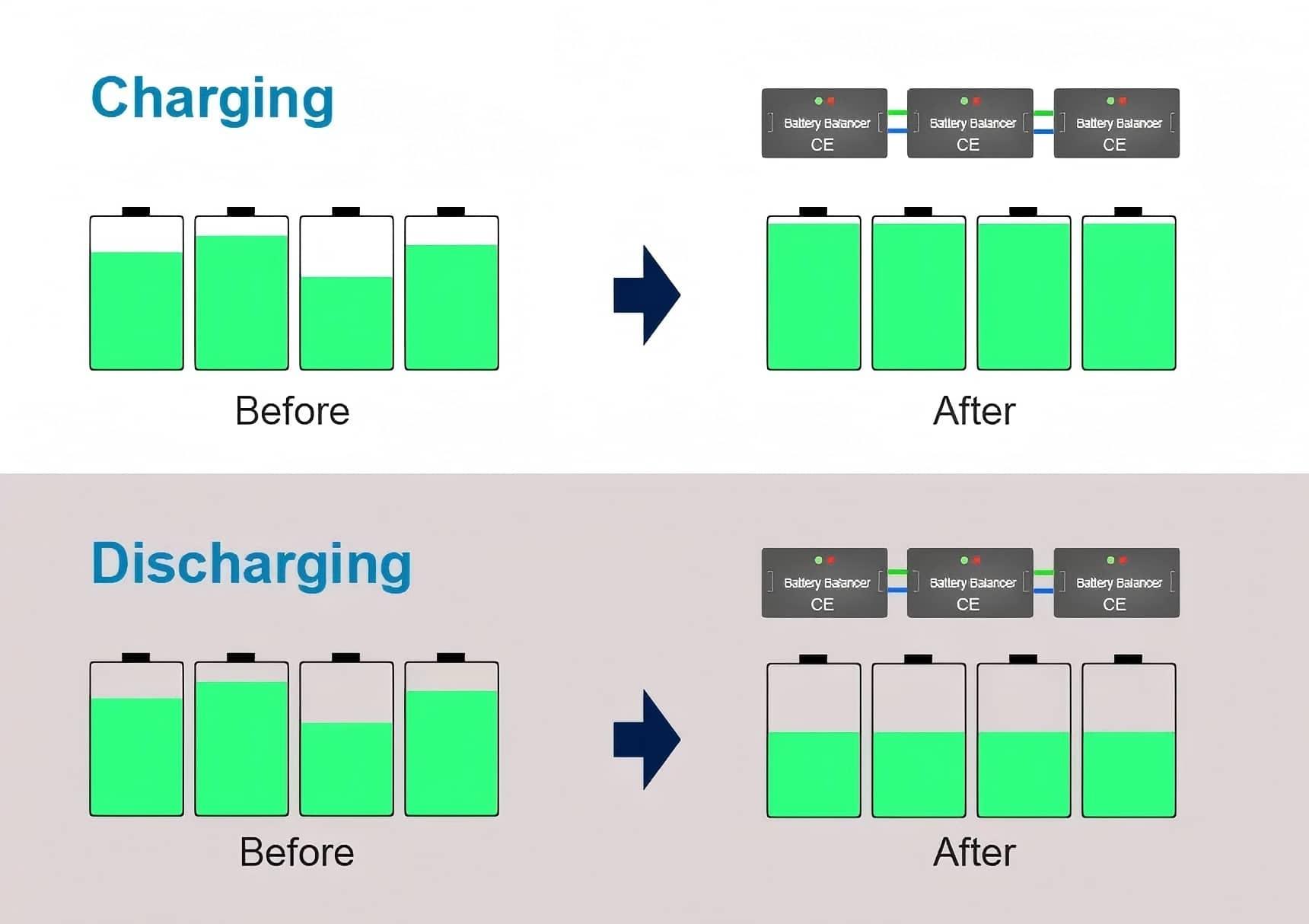
Balancing LiFePO4 cells isn’t just a suggestion — it's a necessity. Proper cell balancing boosts runtime, guards the battery pack against over-charging or over-discharging, and extends its overall cycle life.
Battery balancing — often called cell equalization — refers to the process of ensuring that every cell in a battery pack maintains the same state of charge (SoC) and voltage. When cells become mismatched, the weakest cell limits usable capacity, while the strongest determines the pack’s cut-off voltage. This is often called the “barrel effect.” The resulting mismatch reduces runtime, raises safety concerns, and speeds up battery degradation.
Passive Balancing
Passive balancing works by bleeding off a small amount of excess charge from higher-voltage cells, typically through resistors. It’s straightforward and economical, making it suitable for smaller packs. However, it wastes energy as heat and corrects imbalances relatively slowly.
Active Balancing
Active balancing redistributes charge from higher-voltage cells to lower-voltage ones using DC-DC converters or capacitor-based charge shuttling. This method is more efficient — no energy is wasted as heat — and works better for large or high-capacity packs. It also helps prolong pack life, though it comes with greater complexity and cost.
Top Balancing:
This method equalizes cells when they are fully charged, close to their maximum voltage. It’s ideal when you need maximum usable energy and regularly charge the pack to full. Top balancing also reduces the chance of overcharging a weaker cell during the charging process.
Bottom Balancing:
Here, cells are balanced at a low, safe voltage before charging begins. This approach is preferred when safe and symmetrical discharge behavior is a priority — such as in packs that are frequently deeply discharged.
Rule of Thumb:
If your system undergoes frequent full charges, choose top balancing. If you often discharge deeply and rarely fully recharge, consider bottom balancing.
Manual balancing works for hobbyists and small DIY packs. For larger or commercial packs, always use a suitable BMS along with an active balancer.
1. Safety First
Wear safety glasses and insulated gloves. Work in a non-conductive area, and avoid short-circuiting the cell terminals.
2. Measure Each Cell
Use a reliable multimeter to record the open-circuit voltage of every cell. LiFePO4 nominal voltage is around 3.2–3.3 V; full charge is about 3.6–3.65 V; safe minimum is typically 2.5–2.8 V (always check manufacturer datasheets).
3. Choose Top or Bottom Balancing
Refer to the guidelines above.
4. Parallel Equalization (Common Manual Method)
If cell voltages differ noticeably, you can connect the cells in parallel (positive to positive, negative to negative) — but only if their voltages are within a safe range and you understand the risks. Higher-voltage cells will naturally transfer charge to lower-voltage ones until voltages match. Continuously monitor temperatures and voltages.
5. Top Balance via Controlled Charging
Charge each cell individually to the target full voltage (e.g., 3.60–3.65 V for LiFePO4) using a bench power supply or separate chargers, then assemble the pack.
6. Bottom Balance via Controlled Discharging
Discharge each cell individually to your chosen low voltage (e.g., 2.75–2.80 V), then assemble the pack.
7. Verify with a BMS or Multimeter
After assembly, check each cell’s voltage under no-load conditions. If differences reappear, use an active balancer or replace weak cells.
Important Note:
Manual balancing is slow and carries risks if mishandled. It equalizes voltages but cannot restore lost capacity in aged or defective cells.
Balancing can’t revive a physically degraded or shorted cell. If one cell shows significantly lower capacity or higher internal resistance, the only solution is to replace it — otherwise, the “barrel effect” will continue to limit your pack’s performance.
Q: Do I need to balance a single cell?
A: No — balancing is only necessary for multi-cell packs.
Q: Can a BMS handle everything?
A: A BMS with active balancing covers most needs. For high-capacity packs, an external active balancer may still be beneficial.
Q: How often should I balance?
A: Perform balancing as part of regular maintenance — check weekly or monthly for frequently used systems, before using new packs, and whenever cell voltages drift beyond the manufacturer’s recommended limits.
Balancing is a small but vital investment that protects your LiFePO4 pack, unlocks more usable capacity, and helps avoid costly failures. For DIY enthusiasts, manual balancing combined with a good BMS can be effective. For commercial or high-demand systems, always use matched cells, a quality BMS with active balancing, or a dedicated active balancer.
Next:CALB Unveils Breakthrough Technology, Leading the Green Bus Revolution at Busworld Europe 2025